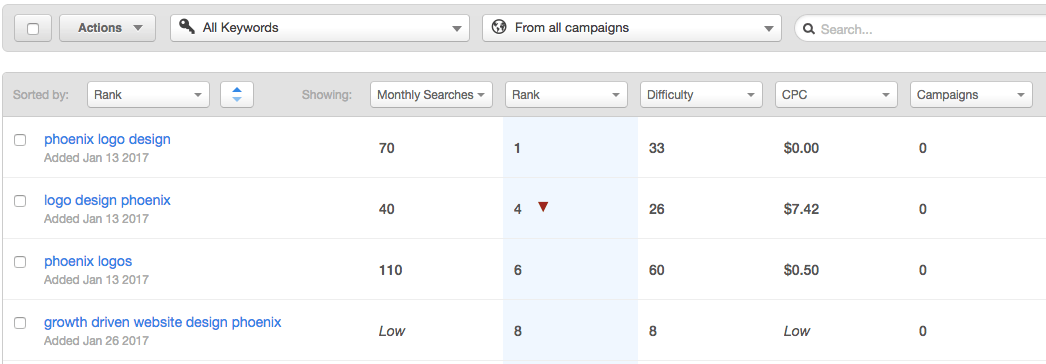How Will an SEO Company Help My Site be Found?
Writing a bunch of blog posts and creating some cool images for your website isn’t enough to efficiently move the needle when it comes to driving visitors to your website. A good SEO company will use data (not assumptions) to help everyone in the room make informed business decisions.
SEO is strategic, highly competitive and much more calculated than many might believe. With all the data available, an SEO company worth their salt is going to actual user data to inform marketing strategy, budget, and measurable return on investment.
Assuming SEO is the plan, here are the 7 core on-page elements that ALWAYS need attention:
1. Establish a keyword research and selection strategy
2. Choose and configure page titles
3. Write captivating meta descriptions
4. Properly use headings and sub-headings
5. Adding images and helping search engines “see” images
6. Setting up a sensible URL structure
7. Develop a content strategy focused on the user’s perspective
1. Establish a keyword research and selection strategy
You first need to figure out what your intended audience actually cares about.
What questions do they have? What are they interested in? What problems are your customers facing? What solutions are they looking for? Where are they looking for these solutions?
It doesn’t do you any good to write about stuff that your prospects don’t care about. So let’s not lead with self-centered stuff like “We offer the best customer service in the country” or “Our team of experts have the experience to satisfy your needs”. If your website is full of this crap, read Defining Your Company’s Market Position immediately.
Keywords are the actual terms and phrases that people type into search engines.
Tools like Hubspot’s Keyword Tool or Google Analytics allow you to research what keywords are most frequently searched, and how competitive the situation is for ranking. This isn’t about guesswork, it’s about looking through data and finding opportunities for achieving listings on the first page of Google.
Every page on your website should be optimized for specific keywords.
For example, let’s say you’re into classic cars. Trying to rank high for the search “classic cars” is going to be really difficult. There are tons of companies and websites out there trying to do the same. It’ll be expensive and time consuming to move up the list, and really hard to stay there. Additionally, visitors that come to your site are going to be really diverse…who knows what kinds of classic cars they’ll be looking for, are they buyers, sellers, etc. All that money and effort wasted.
A better strategy might be to choose your niche and focus like a laser. Ranking high for “Ford Thunderbird Convertibles from the 60’s” is probably much easier, and will deliver you a highly targeted audience that’s more interested in your product.
A scientific approach is best. This analysis can and should be done on day 1, followed by regular assessments and refinements. Rely on data, not some guy’s opinion on what they think could work.
Here’s another example. This web page of ours is focused on “Minimizing Risk in E-Commerce Website Negotiation“.
2. Choose and configure page titles
A page title is the bold text that appears in search engine results and is also what appears up in the top tab of your browser window when you’re viewing the web page. Your page title is really important because it tells your human users what the page is all about (which makes them happy), and also tells those mysterious website crawlers what your site is all about too (which makes search engines happy). Win – Win.
You should be considering the following guidelines when it comes to great page titles:
- Page title should describe what the page is actually about. No misleading anyone…humans or search engines.
- Include your selected keywords naturally. Don’t artificially stuff keywords in places they don’t belong. Users hate it and search engines are smart enough to pick up on it.
- Keywords should be near the beginning of the page title as possible. This is where they’ll have the most value.
- 70 Characters max. Any longer and your title will be cut off in certain web browsers and mobile devices. A long title also dilutes the importance of your keywords.
- Add your company name after the “pipe” at the end of the title.
- Every page should have unique page title on your website. They can be optimized for the same keywords, but titles should be unique.
Example:
“How will an SEO Company help my website get found? | Web Design Phoenix”
Meta descriptions are not going to help you with SEO, but they will help with what we call “click throughs”. These are summaries that come up in search results that give searchers an idea what your page is about…a teaser if you will.
It should be compelling, and accurately describe what is on the page so that users will be enticed to click. Keep meta descriptions less than about 160 characters to avoid getting cut off.
4. Properly use headings and sub-headings
Headings are pieces of text that appear larger on the page than other text. Both users (humans) and search engines (crawlers) tend to pay more attention to headings than regular paragraph text. For this reason, your SEO company should be including your chosen keywords in various headings on each page.
H1 Headings give text more weight than h2, h3, etc., so they should only be used once. Otherwise, the significance of these headings becomes diluted. Feel free to sprinkle in a few sub-titles here and there to support your primary h1 headings.
5. Adding images and helping search engines “see”images
Everyone knows that strong images will improve the user experience and/or facilitate delivering your message (infographics, charts, etc). Images, however carry a few inherent problems when it comes to SEO. Your SEO experts will take care of this, but you should know what’s happening behind the scenes.
Photo Credit: My buddy Andreas Weber – Zugspitze in Germany, 2017
Images are “heavy”. This means that they carry a lot of data and slow the loading of your pages. Users don’t like waiting for pages to come up, therefore search engines don’t like it either. Image resolutions need to be slimmed down, and don’t over use images on any given page.
Use Alt text. Search engines can’t see that cute photo of your dog or the chart about your pricing structure. Use the alt text field to describe what the image is all about…preferably using your keywords. Also, if for some reason the images fail to render, users and search engines alike will still know what message you’re trying to send.
Use keywords in the file name. This can help images be found in image searches and bring traffic to your website. Separate title words with a dash (-) because blank spaces in Urls don’t go over too well.
6. Setting up a sensible URL structure
The url for a web page is the website address you see in your browser. For example, our website url is https://webdesign-phoenix.com. The url is yet another indicator to both users and search engines for what your website is all about. There are also some best practices when it comes to adding new sub-pages:
- Include keywords whenever you can. By way of example, our url contains 3 keywords that we’re very well optimized for…in fact this was the basis of naming our company 20+ years ago.
- Separate keywords with dashes. As I said with images, search engines don’t do well with blank spaces.
- Describe what’s on the page. No misleading…let your users and search engines know what the page is about. A bunch of numbers and random symbols isn’t any value, so create a url naming convention that employs descriptive words.
- Use 301 redirects when necessary. If you change a url or if a page goes away for some reason, set up a permanent redirect to the new page. A common mistake even some experienced SEO firms make is failing to set up a 301 redirect between yourwebsite.com and www.yourwebsite.com. Search engines will treat these two addresses separately otherwise and you’ll lose valuable ranking credit.
7. Develop a content strategy focused on the user’s perspective
When it comes to writing your website content itself, there’s only a couple things you need to make sure of.
Your content is always written with the user’s perspective in mind. Quit talking about yourself and how great your company is. Nobody cares. Think about what your prospects are interested in, what they want to learn about, or provide answers to the problems they have. Your content needs to be helpful and interesting to them, not serve to support your ego.
Put a process in place where new content is produced regularly on an ongoing basis. Letting things get stale will sabotage your SEO efforts…users and search engines hate old or inaccurate information. Those who produce the best content win.
Conclusion
SEO is a long-term, strategic approach to marketing that can deliver enormous benefit by almost every important metric. You may be able to handle all this in-house, or farm the work out to a capable agency. It’s not rocket science, but long-term planning and consistency is absolutely required.
If you choose to outsource some or all of this work, find an SEO company that will guide your strategic decision making, perform the necessary research, and pay close attention to on-page SEO.
If you’d like to learn a bit more about handling SEO and building web pages that are well optimized, check out our ebook The Quick Guide How to SEO






